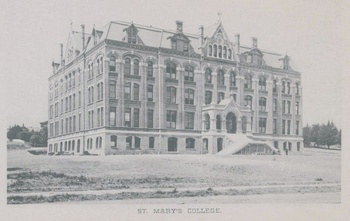 Saint Mary’s College, Oakland, California - 1889
Saint Mary’s College, Oakland, California - 1889
Saint Mary’s College, a men's college founded in San Francisco in 1863, relocated to Oakland in 1889. Its campus was located on the corner of Broadway and Hawthorne. 1
The large, square school building (affectionately known as the “The Old Brickpile”) suffered three major disasters in its nearly 4 decades in Oakland. A fire on Sept. 23, 1894 raged out of control for several hours, destroying enough of the building’s upper floors to leave it unusable for a whole semester; [College President] Bro. Bettelin McMahon (ever the optimist?) had only $20,500 fire insurance for a building worth $350,000 2. The Great 1906 Earthquake dealt $20,000 damage; and a devastating fire in 1918 set things back $250,000 (the fire insurance had been increased, to $50,000) 3. Still, despite the various setbacks, the Christian Brothers persevered another decade in Oakland.
While in Oakland, Saint Mary's gave rise to 30 major league baseball players including Harry Hooper. 4 Beginning in 1921, it had legendary football coach, "Slip" Madigan, who also served as baseball (1926-1930) and basketball coach (1921-1927).
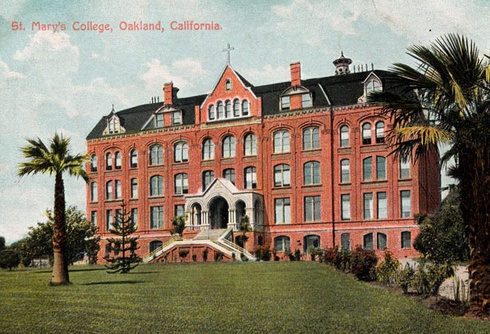 Saint Mary's College, Oakland, California postcard
Saint Mary's College, Oakland, California postcard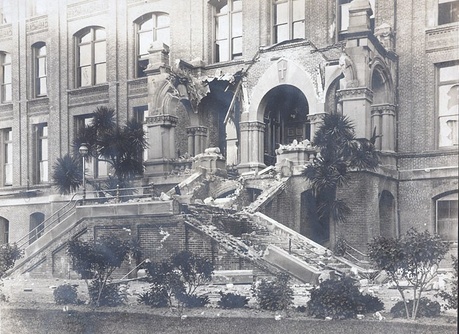 Saint Mary’s College, Oakland, California, damaged during the 1906 Earthquake 1
Saint Mary’s College, Oakland, California, damaged during the 1906 Earthquake 1
By 1928, though, the college had outgrown its Oakland campus; it moved once more, this time to its current location in nearby Moraga. 2
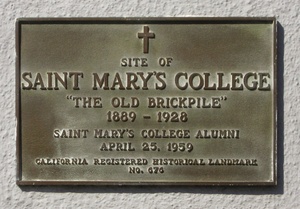 Plaque on Broadway side of “Bay City Chevrolet” building
Plaque on Broadway side of “Bay City Chevrolet” building
What became of "The Old Brickpile"?
Well, it was torn down, of course, and — oh, you mean after that? Well, nowadays probably no one really knows … though a tantalizing bit of old-school Oakland scuttlebutt maintains that the Chryst House designed by Carr Jones and built in 1929 at 1600 Fernwood Drive had (ahem) unusually easy access to vast quantities of bricks – and that these were obtained for a song. And the Houvenin house built in 1932, also designed by Carr Jones, is also alleged to have been constructed with bricks from the old Saint Mary's building. (True or not, good use was certainly made of those materials at both houses!)
Similarly, the pottery studio at California College of the Arts and Crafts is said to have been built with materials salvaged from the old Saint Mary's building.
 1902 Sanborn excerpt - fair use
1902 Sanborn excerpt - fair use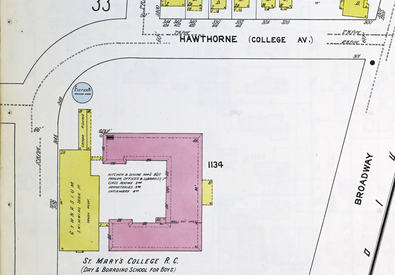 1912 Sanborn excerpt - fair use
1912 Sanborn excerpt - fair use
Notes
- Other sites, including Wikipedia and even St. Mary’s own, erroneously claim 30th Street; but OaklandWiki values accuracy enough to assume nothing in favor of doing original research. (Note that in doing this, it was also determined that the 6th postcard in the above-linked gallery was itself incorrect, naming St. Mary’s but actually showing Holy Names College.) For what it's worth, the 1902 and 1910-11 Sanborn Maps for this area show that the building was close to where Hawthorne originally dead-ended at Webster, with entrances from Broadway close to what was originally known as College Avenue, but was renamed Hawthorne by 1910. Note also that what is now known as 30th Street was originally called Orchard.
- in his defense, the man’s responsibilities were fairly staggering (this may eventually be addressed in another article). Suffice it to say, he was spread very thinly.
- all figures are from “Phoenix Rising” article (linked above).
- Brekke-Miesner, Paul. Home Field Advantage: The City that Changed the Face of Sports. (no publisher info?) 2013.
Links and References
- Saint Mary’s College: History & Heritage
- Saint Mary’s Magazine: The Phoenix: Rising From The Ashes
- Gallery of St. Mary’s Postcards
-
Saint Mary's College of California Wikipedia
-
Educational Work at St. Mary's Told Oakland Tribune August 15, 1928



